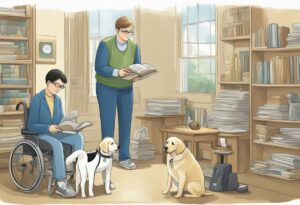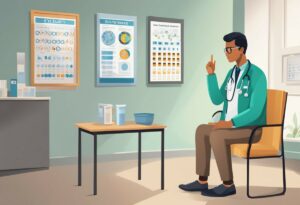Comparing Apples to Apples: In-Depth Analysis of Low Vision Aids

Navigating daily life with low vision can be a challenging task, and finding the right low vision aids can significantly improve an individual’s quality of life. In this comprehensive review, we will explore the various low vision aids available on the market, focusing on their features and effectiveness. From magnification devices to innovative technologies, these aids are designed to help those with visual impairments perform everyday tasks with ease.
One popular low vision aid choice is the Apple iPad, which has been praised for its effectiveness as a reading aid for those with visual impairments. A study found that reading speed on the iPad was comparable to traditional closed-circuit television (CCTV) magnification devices, which have long been considered the standard for low vision reading assistance. Apple has also made strides in accessibility features for a range of vision needs, reflecting the company’s commitment to inclusivity.
In addition to tablet devices, there are numerous low vision aids on the market offering various features and options. Optical aids, such as magnifiers and telescopes, can range from simple handheld tools to head-mounted systems. Moreover, with advancements in technology, there are now electronic aids offering increased magnification, higher contrast, and even text-to-speech capabilities. By understanding the diverse range of products available, individuals can find the most suitable low vision aid to enhance their daily living experiences.
Low Vision Aids: Types and Features
Low vision aids are designed to help individuals with vision impairment perform daily tasks and navigate their surroundings with ease. There are various types of low vision aids available, catering to different needs and functionality. In this section, we will discuss some of the most common low vision aids.
Hand-Held Magnifiers
Hand-held magnifiers and portable magnifiers that provide magnification for a range of tasks, both at near and distance. Available in different magnification levels and sizes, these magnifiers usually have a built-in light source to provide better visibility. Some models even come with a storage case for added convenience.
Stand Magnifiers
Stand magnifiers are devices that rest on a flat surface and provide hands-free magnification. They usually offer a more stable view and are suitable for activities requiring precise control, such as reading or writing. Stand magnifiers can come with adjustable features, such as lighting and magnification strength.
Telescopes
Telescopes are low vision aids used for viewing objects at a distance. These devices can be handheld or mounted onto eyewear. Telescopes come in various powers and designs and may include adjustable focus for optimal resolution.
Binoculars
Binoculars offer magnification for both eyes, enhancing the viewing experience for people with low vision. Like telescopes, binoculars can be used for distant viewing but are more suitable for activities like bird-watching or attending outdoor events.
Autofocus
Autofocus is a feature in some electronic low vision aids, such as portable video magnifiers, that provides clear and sharp images by automatically adjusting the focus. This feature can be especially helpful when viewing objects at varying distances or reading materials with different font sizes.
Braille Devices
Braille devices are designed to assist those who are blind or have severe vision impairments. These devices use a system of raised dots to represent letters and numbers, enabling individuals to read and write. There are various types of Braille devices, including refreshable Braille displays, Braille notetakers, and Braille keyboards.
Screen Readers
Screen readers are software programs that help individuals with vision impairments navigate and interact with digital content. These programs convert text and other visual elements on the screen into speech or Braille, making it accessible for those with low vision or blindness. Examples of screen readers include Apple’s VoiceOver on iOS devices and JAWS for Windows computers.
Comparing Apples to Apples: Features in iOS Devices
Hand Magnifiers in iOS
Apple’s iOS devices, such as the iPhone and iPad, include a built-in Magnifier feature that allows users with low vision to magnify text and images for easier reading. The Magnifier app uses the device’s camera to zoom in on the content and provides additional options such as adjusting brightness, contrast, and filters. To activate this feature, simply go to Settings > Accessibility > Magnifier and toggle it on.
Screen Reader Functionality
Apple devices come with an advanced screen reader, called VoiceOver, built-in for users with visual impairments or those who prefer an audio interface. VoiceOver provides spoken feedback for all elements on the screen and supports various navigation options including touch gestures, a keyboard, or a braille display. To enable VoiceOver, navigate to Settings > Accessibility > VoiceOver and turn it on.
Braille Support
In addition to screen reader functionality, iOS devices offer braille support for users who prefer reading braille. Apple’s Braille display support allows for seamless integration with a wide range of refreshable braille displays, ensuring compatibility and user-friendly functionality. To connect your braille display, go to Settings > Accessibility > VoiceOver > Braille and choose your device from the list of available options.
Camera-Based Magnification
Aiding users with low vision, the Camera-Based Magnification feature on iOS devices enhances the utility of the built-in camera. This feature enables users to quickly magnify printed text, view small objects, or even observe distant objects with ease. Additionally, the Magnifier app supports live image stabilization to minimize blur and provide a clearer image. To access this feature, simply turn on the Magnifier in your Accessibility settings, and use the app to zoom in on the desired object.
Adapting to Visual Impairments
Visually Impaired and Diabetes
People with diabetes are at an increased risk of developing visual impairments, primarily due to diabetic retinopathy. Regular eye exams and proper blood glucose management are crucial to maintain their vision. For those living with diabetes and visual impairments, low vision aids like magnifiers, text-to-speech tools, and high-contrast displays can help them maintain their independence.
Color Filters and Visual Accessibility
Color filters can enhance visual accessibility for those with low vision. Specific color filters can improve contrast, reduce glare, and make reading easier for people experiencing vision loss. Moreover, these filters can be customized to individual preferences and needs through accessibility settings on devices like smartphones and tablets.
Illumination and Visual Comfort
Proper illumination is essential for visual comfort and ensuring the best possible use of one’s remaining vision. Adjustable lighting, like floor lamps and task lamps with adjustable brightness, can cater to individual needs. Furthermore, using glare-reduction shields on screens and positioning light sources at optimal angles can help reduce eye strain and enhance visual clarity.
Training and Adaptation
Adapting to life with low vision often requires training and support. Professionals like occupational therapists or vision rehabilitation specialists can teach individuals with visual impairments various techniques to develop their practical skills. Learning to use low vision aids, utilizing non-visual senses, and improving mobility and orientation skills are crucial components of adaptation and maintaining independence.
Exploring the Technology: Apple Devices
Retina Display: High-Resolution
Apple devices, such as the iPad, are known for their Retina display technology, which provides a very high resolution and crisp visuals. This feature is essential for low vision users since the sharp, clear images can help improve their reading and viewing experience significantly. The Retina display has a high pixel density, which means that the individual pixels are not visible to the naked eye at the normal viewing distance, resulting in a smooth and uninterrupted image.
Size and Distance Considerations
When it comes to low vision aids, the size of the display and the optimal viewing distance are critical factors. Apple devices, such as iPads, come in various screen sizes, offering users the flexibility to choose the one that suits their requirements and preferences best. It is essential for users with low vision to find a comfortable viewing distance, which can vary depending on the individual’s visual acuity and the device’s screen size. In a study conducted by E Morrice et al., it was found that the Apple iPad was as effective as other currently used technologies for improving reading rates in low vision users.
Storage and Performance
Apple devices offer various storage capacities and performance capabilities, ensuring that users with low vision can store their essential data and applications and enjoy a smooth user experience. The storage capability of an iPad or iPhone can range from 32 GB up to 1 TB, allowing users to store apps, documents, and multimedia files without too much hassle. The performance of Apple devices is bolstered by efficient processors like the A-series chips, ensuring that the devices can handle multiple tasks and applications simultaneously, making them suitable low vision aids.
Confident, knowledgeable, and clear, Apple devices cover the essential features required for low vision aids – high-resolution Retina displays, varying size considerations, and functionality in terms of storage and performance – making them a worthwhile option for individuals with visual impairments.
Apples’ Physical Properties
Temperature and Water Content
Apples are typically stored at low temperatures to maintain their freshness and quality. The ideal storage temperature for apples is around 0°C to 4°C (32°F to 39°F). In terms of water content, apples have a high water content, usually ranging between 83% to 90%. This high water content contributes to the juicy texture of apples and plays a significant role in their sensory and nutritional properties.
Mechanical Properties
The mechanical properties of apples are essential in determining their quality and shelf life. These properties include factors such as firmness, elasticity, and toughness. It is crucial to analyze these aspects when assessing apples for their suitability in various applications, such as juicing, baking, or fresh consumption. Apples with higher firmness and elasticity are generally preferred for fresh consumption, as they offer a more satisfying eating experience. On the other hand, apples with lower mechanical properties may be more suitable for juicing or baking.
Hardness
Hardness is a critical factor that influences the overall quality of apples. It is a measure of the resistance of the apple’s flesh against pressure or deformation. Methods such as penetrometry or acoustic measurements can be used to assess the hardness of apples. Instruments like texture analyzers can also provide objective data on the hardness and related parameters, assisting in predicting the sensory perception of apple texture by instrumentally measured parameters 1. Generally, consumers prefer apples with a crisp and firm texture, while softer textures may be undesirable for some.
Accessibility
Conclusion
In summary, low vision aids play a crucial role in enhancing the quality of life for individuals with vision impairment. A wide range of products are available, each with its unique features and benefits. With advancements in technology, devices such as the Apple iPad have emerged as viable low-vision reading aids, expanding the options for users.
It is essential for both clinicians and individuals with visual impairments to carefully assess their specific needs and preferences when selecting a low vision aid. Factors to consider include the nature of the vision impairment, the user’s lifestyle, and their comfort with using assistive technology.
As evidenced by a scoping review, traditionally available clinical factors may not be enough to predict device use, suggesting that consistent monitoring and evaluation are necessary to ensure optimal outcomes.
Finally, continued research and development in the field of low vision aids will lead to more innovative products and solutions. By staying up-to-date with advancements, professionals and users alike can ensure they are best equipped to manage the challenges presented by vision impairment.
Frequently Asked Questions
What are the most effective low vision aids for macular degeneration?
There are various low vision aids available for individuals with macular degeneration. Some popular options include magnifiers, video magnifiers, and adaptive technology for electronic devices. The effectiveness of these aids depends on the individual’s specific needs and preferences. Consulting with a low vision specialist can help identify the most suitable aids for each person’s unique situation.
Which types of low vision aids are suitable for Apple devices?
Apple devices, such as iPhones and iPads, come equipped with built-in accessibility features designed to assist people with visual impairments. Some of the popular tools include VoiceOver, Magnifier, Zoom, and Invert Colors. Additionally, there are external low vision aids such as screen readers, Braille displays, and portable magnifiers that can be connected to Apple devices to enhance usability.
How do iPads benefit visually impaired seniors?
iPads offer various benefits for visually impaired seniors. They feature large screens, customizable text sizes, high contrast display settings, and accessibility tools tailored for individuals with lower vision. iPads also provide access to a wide range of applications that can aid in everyday tasks such as reading, communication, and navigation for visually impaired users.
Can Apple Watches be used by those with low vision?
Yes, Apple Watches can be used by individuals with low vision. The devices come with accessibility features such as VoiceOver, Zoom, and Extra Large Watch Face that cater to the needs of those with visual impairments. These options help make the interface and notifications on the smartwatch easier to see and interact with for low vision users.
What are some key features of Apple’s assistive technologies for the visually impaired?
Apple’s assistive technologies for the visually impaired include VoiceOver, a screen reader that provides audio descriptions of on-screen elements; Magnifier, which turns the device’s camera into a digital magnifying glass; Zoom, for enlarging the screen and making it easier to read; and Invert Colors, which increases contrast on the display. These accessibility features are available across various Apple devices like iPhones, iPads, and Apple Watches.
How do low vision aids like telescopes integrate with Apple devices?
Some low vision aids, such as telescopes and monoculars, can be attached to Apple devices via mounting systems or clamps. This allows users to easily view objects at a distance or read text on-screen with greater magnification. Some specialized apps can also turn these devices into portable video magnifiers, enhancing the viewing experience for individuals with low vision.




